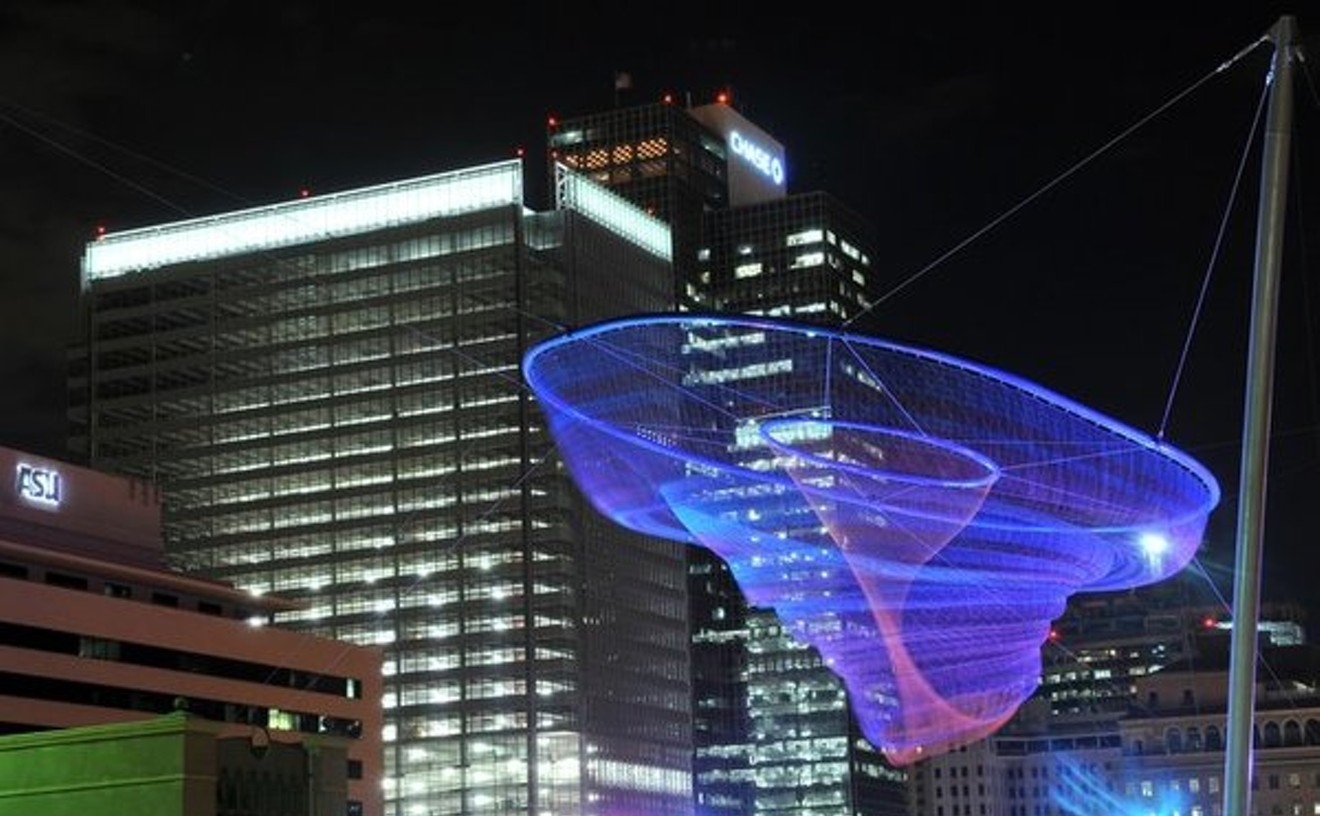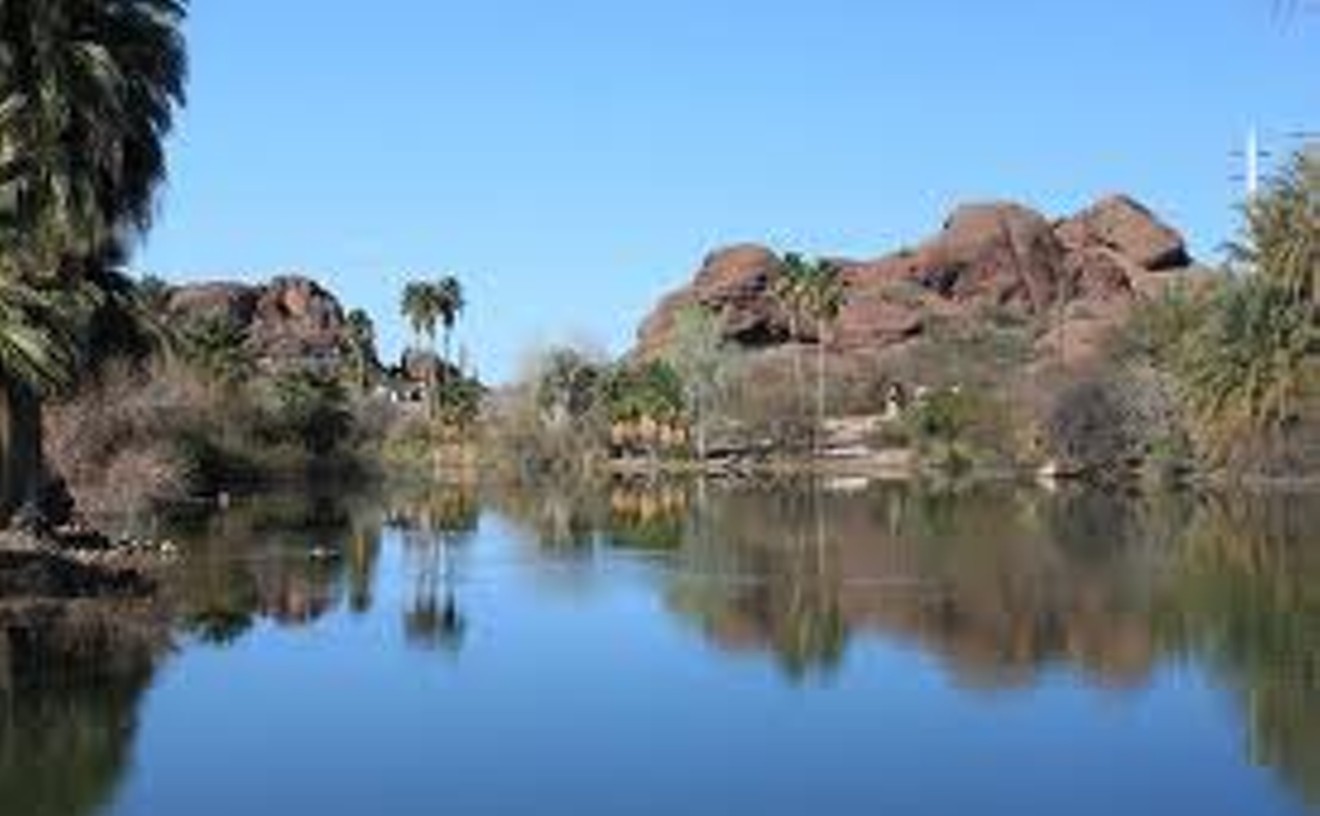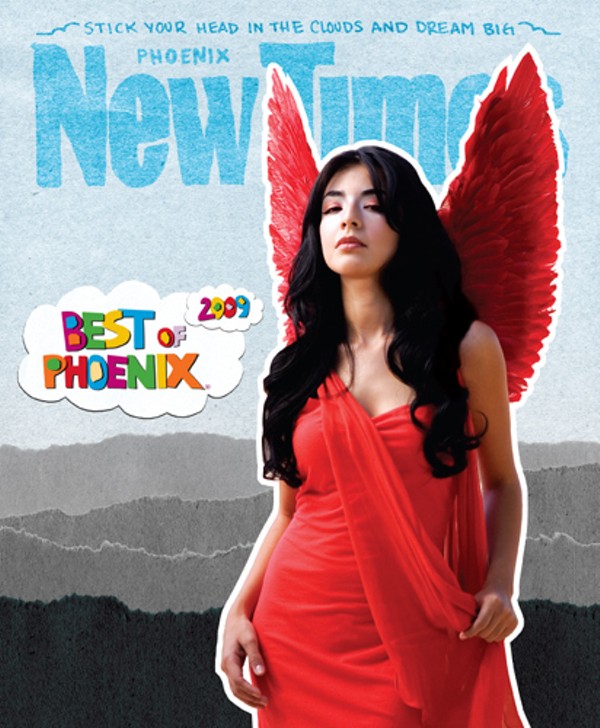to the city hotline to get it covered up as quickly as the next guy. But all graffiti isn't vandalism. Sometimes, it's art. And, oddly enough, the best example of graffiti art in town isn't stretched out in public. In an alley behind La Piñata, the Mexican restaurant on 19th Avenue just north of Osborn Road, is our Louvre of mural-based graffiti. Unlike some spots where graffiti is thrown up without permission, here the work is encouraged by the local businesses, and the paint donated by Montana Spanish Paints. Nearly 100 feet of urban landscape, including aliens, weirdos, flaming hubcaps, burning motorcycles, purple people, and an impressively large color block pattern almost 20 feet high, lines the back of the little strip mall. Instead of bland, boring, and illegal, these vivid murals, although hidden, are reminders that all graffiti isn't vandalism. A little permission, a little paint, and a little skill make all the difference.
Best Graffiti
Behind La Piñata
It became difficult to understand how robots could be portrayed in science fiction as threats after seeing Atticus Fraley's installation. The "Bell'e Art" series, presented by Scottsdale Public Art, rotates art in the Scottsdale Civic Center Bell Tower. We haven't loved every project (frankly, the bubble fountain was disappointing and smelled bad), but we were delighted in early 2009 when an onslaught of flying robots filled the space. Fraley used vintage recycled objects — like U-shaped magnets for hands, industrial light bulbs for heads, thermoses for legs and picnic jugs for bellies. These little guys were soaring, parachuting, and coptering in for an adorable onslaught. At night, with their lightbulb heads aglow, all of Scottsdale welcomed this invasion. We were sorry to see the robots go, but last time we checked, Orange Table — the groovy coffee house adjacent to the art space — was memorializing them on T-shirts.
Best Castle
Tovrea Castle

Like so many things in Phoenix, Tovrea Castle isn't what it appears to be at all. This peculiar, turreted house, built in 1928 in what was then literally the middle of nowhere at 50th Street and Van Buren, looks more like an attraction at a miniature golf course than a building inspired by the homes of Italian noblemen. Seen from eastbound Loop 202, Tovrea (pronounced Toe-vree) is a flag-topped, dome-roofed faux castle in the middle of the Southwest desert, a kitschy reminder that Phoenix was once even weirder than it is today, and a testimony to the fact that the city's inability to finish anything isn't a new trend.
The castle and its surrounding Carraro Cactus Garden were built by Italian immigrant Alessio Carraro, a San Franciscan who'd hatched a plan to create his own resort town on 277 acres of creosoted desert just east of the Phoenix city limits. He intended to build a resort castle surrounded by dense acres of vegetation, and between 1928 and 1930, he and a crew of two dozen workers overhauled the barren landscape into a colossal cactus garden, designed by a Russian gardener named Moktachev and wrapped around a magnificent wedding cake of a house meant to be the crowning jewel of a privately owned housing development that never came to be.
Instead, we're left with a pretend castle, five separate gardens, various outbuildings, and some goofball water features that — because the City of Phoenix purchased the castle and the 36 acres of land surrounding it in 1993 — local Tovrea fans and tourists alike can enjoy during the castle's twice-monthly garden tours. Every penny of the $15 admission price goes toward upkeep of the recently restored castle and grounds, which you can see for yourself by reserving a spot on its next tour on the castle's Web site.
- 5041 E. Van Buren St., Phoenix, 85008 Map
- 602-256-3220
- www.phoenix.gov/PARKS/tovrea.html
Best Public Art
Her Secret Is Patience by Janet Echelman

No pun intended, but it's a wonder that Her Secret Is Patience, a massive sculptural installation by Boston artist Janet Echelman that now anchors downtown's new Civic Space Park, ever got built to begin with. Inspired by Arizona's monolithic monsoon clouds and the fleeting flowers of the state's iconic saguaro cactus, Echelman's ethereal creation of free-floating netting and steel, which changes with the wind and is kaleidoscopically uplighted at night, almost never got built — thanks to a city government faction that wanted to dump the project mid-stream. But public support and the commitment of the Phoenix City Council ultimately won out. The sculpture, which had been dissed as resembling everything from a jellyfish and collapsed sphincter to a thought balloon and cowpie, is now the eye-popping focal point of the city's newly opened downtown park across the street from ASU's Walter Cronkite School of Journalism. More impressive against a nighttime sky than its daytime backdrop, Her Secret Is Patience hypnotically draws people in like moths being sucked into a multi-colored, ever-changing flame.
The name of Echelman's massive sculpture is unforgivingly appropriate. It comes from a quote penned by Ralph Waldo Emerson, 19th-century American Trancendentalist poet, philosopher, and essayist: "Adopt the pace of nature; her secret is patience." Emerson is the same guy who once wrote, "To map out a course of action and follow it to an end requires courage." And courage is what it took to get Echelman's artwork up and butting against the sky.
- 424 N. Central Ave., Phoenix, 85004 Map
- www.phoenix.gov/parks/index.html
Best Performance Art
"Angela Ellsworth: Underpinnings"
Phoenix multi-media artist Angela Ellsworth is always coming up with brand-new ways of making salient points about art, life, culture, societal mores, and just plain stuff. She scored again, big-time, with an eminently memorable live piece performed January 8 in conjunction with her exhibition, "Angela Ellsworth: Underpinnings," at Lisa Sette Gallery.
As a tribute to pioneering female performance artists of the 1960s, '70s, and '80s, Ellsworth dressed rosy-cheeked young ladies, outfitted like "sister wives" of the infamously polygamous Fundamentalist Church of Latter-day Saints, in missionary-style, Mother Hubbard muumuus, frontal hair poufs, long, fake braids, and running shoes. In slow motion, they roamed the gallery that evening, silently miming past performance art while armed with objects — a machine gun, a rag stuffed in a mouth, a flashlight — used in the older, still-controversial works. The flashlight was used to illuminate the crotch of another, reminiscent of Annie Sprinkles' 1989 Public Cervix Announcement, during which the hooker/stripper/porn star turned feminist performance artist invited people to celebrate the female body by using a flashlight and speculum to see her cervix.
God only knows what people passing the gallery during this scenario thought when they got a gander at the goings-on, but it was fun to speculate. We don't think Scottsdale will ever be the same.
Best Craft as Art
Hyperbolic Crochet Coral Reef Project
Billed as "a woolly celebration of the intersection of higher geometry and feminine handicraft," April's "Hyperbolic Crochet Coral Reef Project" — the brainchild of Margaret and Christine Wertheim of the Institute for Figuring (IFF) — turned out to be so much more than that. The Wertheim twins are not only artists, but scientists and writers as well — who better to meld art in a traditionally feminine form with hardcore mathematics, geometry, biology, and ecology?
Their crazily colorful, 2,500-foot coral reef, constructed entirely of crocheted materials (including those obnoxious plastic bags that are such a pain to recycle) oozed over, under, and through the Scottsdale Library's gallery, evoking the real, living, breathing thing. Of course, the danger posed to the world's coral reefs by pollution, including that produced by those damn virtually indestructible plastic bags, is underscored by the project, which was realized with the help of over 200 local volunteers. "Hyperbolic Crochet Coral Reef Project" turned out to be the consummate, water-evoking oasis when our legendary heat arrived this summer.
Best Street Party
Martha + Mary Fundraiser
We always applaud efforts to raise money for arts-related projects in the Valley. And we were especially impressed with a street party-cum-art exhibit sponsored by Martha + Mary, a group formed by artist/real estate developer Sloane McFarland that's dedicated to resurrecting Phoenix buildings from the dead and turning them into ultra-hip urban hangouts, like Lux Coffeebar on Central Avenue.
Martha + Mary's April family-friendly bash (you could tell the clientele it attracted by the Vespas parked en masse out front) was an open-air affair in a blacktopped area next to Lux and featured live music, comfort food and drink, and kid-centric games and activities. All proceeds from the street fair went to underwrite ASU Art Museum's upcoming "Open for Business" exhibition, a clever fundraising idea at a time when the budgets of museums and other cultural institutions have been slashed more savagely than a Freddy Krueger victim.
But the real draw of the afternoon was a four-hour exhibition by some of the Valley's most talented artists, including Jon Haddock, Gregory Sale, Carrie Marill, Sue Chenoweth, Matthew Moore, and Post-Commodity's Steve Yazzie and Kade Twist. Video, multi-media installations, wall painting, three-dimensional sculptures, drawings — all this and only four hours to enjoy the formidable show. Here's hoping that the street fair/exhibit becomes an annual spring event. And maybe if we beg, plead, nag and whine, next year's exhibition will remain open for viewing a lot longer.
Best Visionary
Paolo Soleri
Sometimes we wonder whether legendary Italian architect Paolo Soleri isn't feeling a little smug these days. All signs point to no: The 90-year-old trailblazer was nothing but gracious during his birthday celebration in Scottsdale in June. He took time to pose for photos with families and fans, sipping water, nibbling on a scone, listening intently, and sitting through the heat for much longer than would be considered healthy for most men nearing 100. (Though, admittedly, most men nearing 100 aren't cementing their legacy in that decade).
But how could he not be? This is a man who was prophetic about one of the most urgent issues on the radar today: sustainable living. (He thought of it about a generation earlier than the rest of us.) More than 50 years ago, he founded the Cosanti Foundation, and 10 years after that, he began building one of the most ambitious architectural projects in the country. Arcosanti is an entire city in the desert that, when finished (if ever), was designed to house 5,000 people and take up only 25 of 4,060 acres of land. His idea was to create an alternative to urban sprawl, a city that works more like a complimentary organism than a never-ending growth spurt. Arcosanti looks something like a space-age community built entirely out of the dirt, sand, and stone. It is both modern and retro, beautiful and rugged.
The experimental community is basically in the middle of nowhere, located about 50 miles north of Phoenix along Interstate 17. It is (at least the beginnings of) an entirely new kind of city — one that conserves energy, land, and resources. In other words, it is (cough, cough) sustainable. In fact, Soleri's 50-year-old philosophy is based on a theory of sustainability: the combination of architecture and ecology (i.e. arcology; check it out on his Web site). Feeling a little silly yet? Maybe if we'd listened to him 50 years ago, we wouldn't be facing ozone high-pollution advisory days now.
Either way, the city of Scottsdale and Scottsdale Public Arts seem to have gotten the message — and they're bringing it to us in the form of the Soleri Bridge and Plaza, which will cross the canal at Scottsdale Road just west of Camelback. The project, designed by Soleri and partly built by his groupies at the Cosanti bell foundry in Paradise Valley, will feature two 64-foot pylons that will cast shadows to mark the course of the sun and a suspension bridge, as well as areas for walking and biking (and horseback riding, apparently). Okay, so ours is no revolutionary, self-sustaining city in the desert, but it will hopefully be a suitable tribute to our favorite architectural, environmental, ecological, artistic visionary. We salute you, Signore Soleri.
Best-Named Park
Evelyn Hallman Park

When we heard there's a park in Tempe named for the current mayor's mother, we rolled our eyes. Nice gimme, Hugh! Then a friend corrected us. Turns out Evelyn Hallman is more than deserving of the honor.
Hallman, a seamstress, wife, mother of three, and, at one point, diesel mechanic, still managed to find the time to get involved in local politics. A Goldwater Girl who became a virtual pillar of her community, Hallman knew every corner of her north Tempe neighborhood — and she really knew Canal Park.
Back in the day, when Canal and Papago became pick-up spots, Hallman lobbied the city to clean up the parks and close down the bathrooms used for dalliances. She persuaded county officials to sponsor annual neighborhood park cleanups, which continue to this day.
Evelyn fought for open spaces where neighbors could gather together to enjoy fishing in the pond, a bike ride or a stroll. She worked tirelessly to apply for grant money for her neighborhood and attended countless city meetings to support good projects in the neighborhood and oppose bad ones. She celebrated when a good project won out and took it in graceful stride when a bad one did.
She fought developers who wanted to build on A Mountain, which today is still covered with vegetation and a hiking trail. She also made sure we could enjoy walking around Tempe Town Lake without bumping into commercial properties right at the lake's edge.
Evelyn created partnerships, made enemies and built a community of neighbors. Tall like her son and tan, she could be found every morning in Canal Park, jogging along the canal, well into her '80s. She died in 2005 and in 2006, Canal Park was re-dedicated as Evelyn Hallman Park. We can't think of a better tribute or reminder of the value of community activism. As Evelyn Hallman's life proves, you don't have to be the mayor of a town to get things done in it.
- McKellips Road and College Ave., Tempe, 85281 Map
Best Politician
Barry Goldwater
LBJ's people smeared him as crazy. They said he was too far right, that (per that awful "Daisy" ad) he'd usher in World War III, that the stakes were simply "too high" to trust him with the country. "In your guts, you know he's nuts," they chanted. And then Barry Goldwater lost the presidency — the first in a long line of Arizonans to fall just a bit short of the ultimate political goal.
But something strange has happened to Goldwater in the 40-plus years since he ran for president. You only had to watch his granddaughter CC's 2006 documentary, Mr. Conservative, to realize how wrong the media elite had been about Goldwater. He wasn't crazy. He was, instead, a creature of the West: an independent, a straight shooter, a guy who understood that there's nothing on the Eastern seaboard that rivals the beauty of a sunset over Paradise Valley. And he was smart. Read The Conscience of a Conservative today and — though you may not agree with a word of it — we guarantee you'll be struck by its lucidity and logic.
You don't have to be a conservative to appreciate his legacy. Goldwater tolerated no corruption; he didn't mince words. He sat down with a tarnished Nixon and persuaded him to resign. He called out his own party when it got too hung up on gays and abortion. Then it was the right's turn to smear him — they said he'd left the movement he helped to create. But really, the movement left him.
Forget the Straight Talk Express. This was a man who told it like it was. And screw Sarah Palin . . . Goldwater was the true maverick.
Of all the Arizonans who've played the political game, Barry Goldwater is the one we're most proud of today. Even if you didn't agree with Goldwater on anything, it's hard not to respect him for just about everything.





